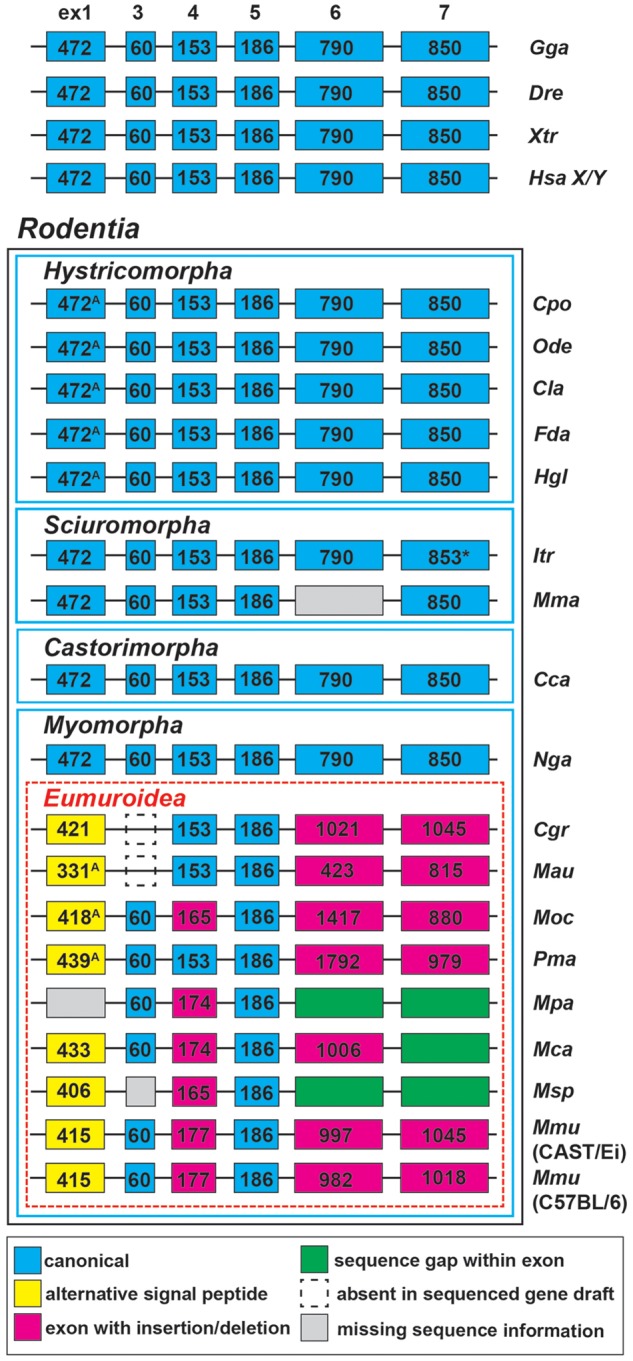Fig. 3.

Variations of NLGN4 exon sizes in selected vertebrates and rodents. NCBI deposited DNA sequence information of 18 rodent species and four selected vertebrate species including human (Homo sapiens, Hsa; NLGN4X Gene ID: 57502, NLGN4Y: 22829), chicken (Gallus gallus, Gga; 428006), zebrafish (Danio rerio, Dre; LOC108709161/LOC108707974), and clawed frog (Xenopus tropicalis, Xtr; NLGN4a: 561122, NLGN4b: 100147967) were used for comparison with available rodent NLGN4 coding sequences. Notably, the selected vertebrate species as well as guinea pig (Cavia porcellus, Cpo; 100714631/106025955), degu (Octodon degus, Ode; 101591647), chinchilla (Chinchilla lanigera, Cla; 102015543), darma-mole rat (Fukomys darmarensis, Fda; 104848054), naked mole (Heterocephalus glaber, Hgl; 101715794), 13-lined squirrel (Ictidomys tridecemlineatus, Itr; 101974873), American beaver (Castor canadensis, Cca; LOC109703453, LOC109679926, LOC109674687), and the upper-galilee mole (Nannospalax galili, Nga; 103725635) display identical exon sizes. Within the clade eumuroidea (i.e., the rodent infraorder myomorpha excluding the family spalacidae; to which Nga belongs), the neuroligin-4 coding sequence encoded by exon 1 consistently decreases whereas the sizes of exons 6 and 7 increase. NLGN4 exon 3 is absent in both, the golden hamster (Mesocricetus auratus, Mau; 101837222) and Chinese hamster (Cricetulus griseus, Cgr; NW_006882737.1) gene sequences; however, it is still present in the prairie vole (Microtus ochrogaster, Moc; 102001548) and deer mouse (Peromyscus maniculatus, Pma; 102911426). Within the genus Mus size variations are present in nearly all exons despite exons 3 and 5 (Mus pahari, Mpa: NW_018393795.1; Mus caroli, Mca: NW_018389566.1; Mus spretus, Msp: LVXV01024335.1). *, insertion of an additional single base triplet; A, possibility of alternative start codons. Labeling of exon boxes reflects respective base count. Blue frames separate species of different rodent infraorders, a dashed red frame outlines the clade eumuroidea. An extended version with a more refined clustering of additional families within the clade eumuroidea can be found in supplementary figure S2, Supplementary Material online.
